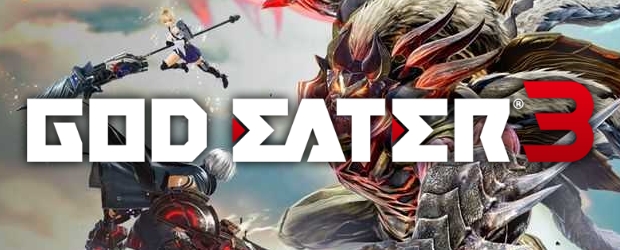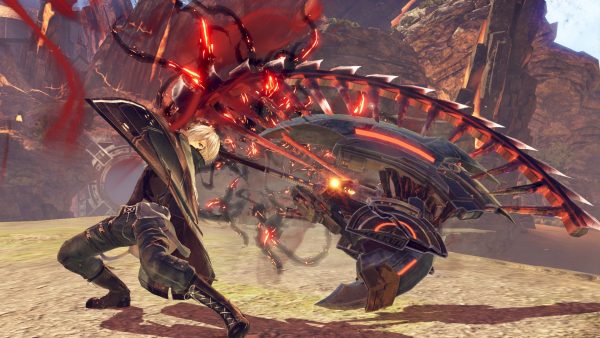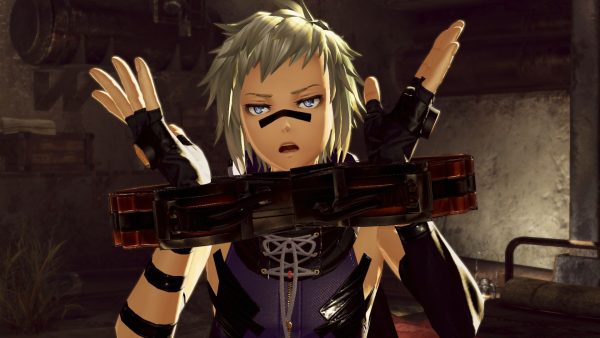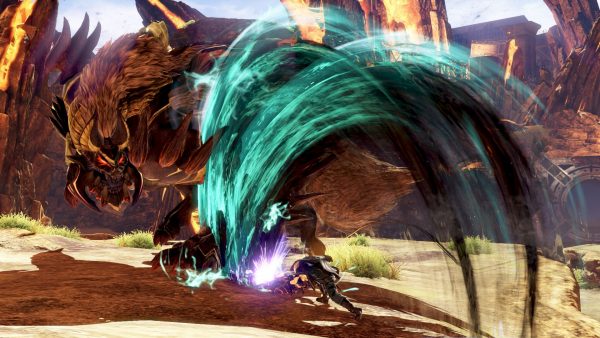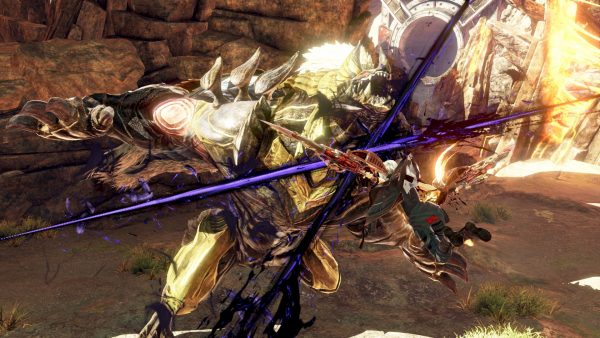Switch to: German
After Monster Hunter became a massive hit on the PSP, there were many attempts to replicate its success. God Eater managed to set itself apart from the crowd thanks to its unique enemy designs and mechanics, but it has never managed to garner the same attention as the series it was inspired by. While I don’t think this will change with the release of God Eater 3, this latest entry is still worth trying.
The events of God Eater 3 take place a few years after the events of God Eater 2: Rage Burst. The world is still under threat from Aragami, beings that exist only to consume and can change form based on what they eat. Due to an unexplained event that takes place before God Eater 3, the battle against the Aragami has taken a turn for the worse, and what used to be Europe has change into the inhospitable Ashlands. The only ones who can effectively fight in the Ashlands are Adaptive God Eaters, who are resistant to the effects ash has on regular humans.
As with the last two games, you create the main character using a somewhat limited amount of customisation options. There are only a few different faces to choose from, along a few accessories and costumes to try and make your character look unique. It’s a shame that there weren’t more ways to design your character, especially in a game like this where they’ll be appearing in most of the cutscenes. They also have little real impact on the story itself, usually just standing around while the other characters have their own conversations.
As for the story itself, it has some interesting moments, but most events are over before they’ve really began. Coming from God Eater 2 the faster pace is somewhat appreciated, it’s just that instead of being overly drawn out, the story passes by too quickly. The overall cast of characters was made smaller, but many of them are still given little time to develop. Hugo, the main characters childhood friend, is one of the few characters that is handled well, but the rest of your allies end up being ignored for most of the story. God Eater 2 featured character episodes, small sets of events that helped to add more personality to even some of the minor characters in the game. These would have been welcome here, as they’d not only make the cast more interesting but also give the player more to do than just the main story.
Another noticeable issue with the story comes from the English voice acting. It doesn’t have the horrendously low audio quality like in God Eater 2, but it still doesn’t sound quite as good as the Japanese audio. Many lines are also delivered poorly, either putting emphasis on the wrong words or not conveying the right emotions. It’s far from the worst dub we’ve heard but it could have been so much better.
When it comes to battling Aragami, not much has changed from the most recent release of the first game God Eater: Resurrection. Basic attacks are still quick, even with heavier weapons like the hammer, and you can dash to avoid attacks. The newly added dive move also allows for quick movement around the map, something that you’ll rely on often to chase fleeing Aragami or just collect materials quickly. The burst mechanic is also here, being one of the more unique parts of the God Eater series. Every God Arc, the weapons that God Eaters use to fight Aragami, has the ability to devour enemies to power up its user. Devouring lets you enter burst, which strengthens your offence and defence along with granting access to a helpful double jump. Burst can be stacked up to level 3, though getting past level 1 requires allies to use link burst, something that is also gained by devouring. Burst management is a big part of successfully completing missions quickly, though your AI partners can be hit or miss when it comes to using link burst.
This isn’t the only mechanic that is used to try and encourage cooperation. The newly introduced engage requires you to stay close to allies during battle so that you can active different stat boosts. When engage is activated, two allies gain both positive effects that they each set before the mission. These effects are usually not too powerful, but can help to take down Aragami faster. Another new feature, accelerate, also offers small temporary effects if you fulfil certain conditions. Accelerate feels even less impactful than engage, and it would have made sense to just use a more powerful version of one of these mechanics instead. For example, God Eater 2: Rage Burst had a similar feature to accelerate that offered far greater benefits but also required more work to activate. This not only gave a more noticeable power up to your character, but also made battles far more interesting.
At the very least, the new weapons that were added into the game are unique and can be a lot of fun to use. The heavy moon is the weapon we used for the majority of mission, and it’s a strange mix of chakram and axe. Even being the second slowest weapon in the game, it’s still quick compared to heavy weapons in games like Monster Hunter and Toukiden. Each weapon also has access to burst arts that can modify ground, air and dash attacks. These can only be used during burst, making devouring even more important. Burst arts can drastically change the feel of a weapon and are a welcome addition .
Combat is enjoyable overall, even with some bland mechanics here and there, and the high speed of battles is a breath of fresh air compared to other hunting games. The main issue however is that God Eater 3 is just too easy. Aragami go down incredibly quickly – only a couple of missions took us longer than 10 minutes – and as you go through the ranks they never gain any new attacks. When the story is hyping up an enemy as incredibly powerful and you end up killing it in less than 5 minutes, it ends up being somewhat disappointing. The hardest missions are the ones where you’re fighting multiple Aragami at once, and even then you can just use your AI partners to split them up. There also aren’t that many missions even if you include optional ones, each difficulty rank before the post game have only a handful of extra missions to do.
One area that has definitely been improved over the previous games is God Eater 3’s presentation. Being the first game not designed for handhelds, the visuals are far nicer and it’s great to see what the older Aragami look like when not held back by system limitations. Breaking Aragami parts is especially satisfying thanks to the new break animation and sound effect. One unfortunate graphical issue that was present in the previous God Eater games, AOE markers not working properly when on slopes, is still not fixed even with the visual improvements. They still clip into the ground and can make avoiding certain attacks difficult.
Conclusion
God Eater 3 is a good attempt at improving an already decent series, but a few key problems stop it from being a true classic. The various changes and refinements made to the typical God Eater gameplay are welcome for the most part, and as long as you can deal with a lack of content and challenge there is definitely fun to be had.



